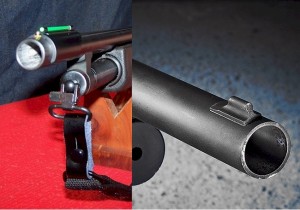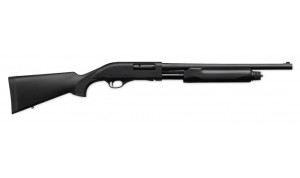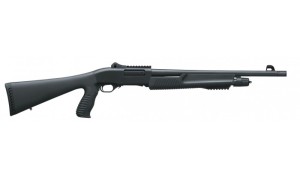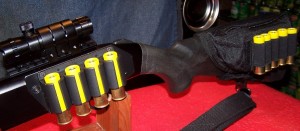
I Don’t Care Who You Are, These Bores are Impressive! Mossberg 20-Gauge on left and Weatherby 12-Gauge on Right
The average 12-gauge tactical shotgun weighs between 7.5 and 8.5 pounds. The 12-gauge load most often recommended for home defense is the standard 2 ¾-inch No. 4 buckshot load holding 27 pellets, launched at 1,100 to 1,200 fps. Each pellet is .24-caliber, weighing approximately 20 grains. It’s a very effective close-range load.
In popular 3-gun matches, the semi-automatic 12-gauge shotgun is the primary choice. These are highly-specialized shotguns run by highly-specialized people in a competition setting. The prices of most of these shotguns are beyond the reach of the common guy who can only afford a Tri-Star or Mossberg Maverick shotgun. When most folks think home defense, the 12-gauge shotgun usually enters the mind first. A 20-gauge shotgun would be considered a step-down for a defensive shotgun.
My Son-In-Law, who is a strapping fellow of seventy-six inches in height, was of the 12-gauge school of thought – until recently. He surprised me by saying that he wanted a good 20-gauge for the house. When I inquired why, he simply stated that the 12-gauge (a Mossberg Maverick) was just too heavy and cumbersome. Going further, he stated that he needed the wife to be able to shoot it as well and the 12-gauge was just too much for her to handle. That answered my question as to the change in thought. Home defense is a family affair.
The average 20-gauge tactical model with the 18.5” barrel length tips the scales at between 5.5 and 6.5 pounds. The standard 2 ¾-inch 20-gauge buckshot load contains 20 No. 3 buckshot pellets, launched at 1,100 to 1,200 fps. These are .25-caliber and weigh slightly more than No. 4 buck. It’s also a very effective close-range load. From a cylinder-choked gun, they normally deliver an 11- to 12-inch pattern at 10 yards, and with less recoil than the 12-gauge.
“The 20-gauge is much easier to shoot than the 12-gauge, produces significantly less recoil, and is lighter and more maneuverable,” says retired SWAT team leader and multi-level certified self-defense instructor Steve Denney, who currently serves as the general manager of Pro Arms Inc., in Live Oak, Fla. “It’s a shotgun that virtually any member of the family can master, and at the ranges that are encountered in home-defense situations, it is just as effective as a 12-gauge.” The 20-gauge also has plenty of stopping power.
Have I stopped becoming an advocate for the 12-gauge? Not hardly, but home-defense situations are normally close, quick, and fluid. The lighter gun has an edge in handling and is especially suited for smaller-framed family members who may have to wield it.
Two 20-gauge shotguns, which are reasonable in price for most, have my vote; the Mossberg 500 Tactical and the Model 870™ Express® Synthetic 7-Round.
While the Mossberg 500 Tactical only has a 6+1 round capacity, the safety is on top of the receiver where I like it. Another feature of the Mossberg 500 Tactical is the capability of adding a scope base on top of the receiver to receive an optic. The Mossberg SA-20 International is also a viable option for defensive purposes, although some might regard the 20” barrel and 5+1 round capacity negatives. The Remington 870 Security has a 7+1 round capacity with the safety just forward of the trigger on the trigger guard. Optic mounting options are not available on the receiver of the shotgun In Addition, Weatherby has also stepped up to the plate with their “Threat response” line of shotguns. The PA-08 TR in 20-gauge is a very affordable with its pump-action 4+1 round capacity and the 6+1 semi-automatic SA-459™ TR, which is a step-up in action and price.Of the three 20-gauge shotguns mentioned, the Mossberg and the Remington are the most common.
Defensive ammunition is, of course, not as common for the 20-gauge as is for the 12-gauge. The most common is the slug and #3 buck shot for home defense. I prefer standard 2 ¾” shells and they are more than suitable for the intended purpose. Moving to 3” shells places the 20-gauge in the lower 12-gauge realm of recoil and with a lighter weight shotgun than the 12-gauge, the experience of shooting 3” shells is not so pleasurable. Both the Remington Slugger 20-gauge, 2 ¾”, 5/8-ounce slugs and Remington Express #3 Buck have performed without flaw in my shotguns. Due to the fact that most of my 20-gauge ammunition purchases are on-line, I tend to keep an ample supply of both – especially when I catch them on sale.
The bottom line is that the 20-gauge shotgun is no slouch in the home defense department. Will I give up my 12-gauge shotguns? Not hardly. When significantly less recoil, and a lighter and more maneuverable shotgun is needed, the “Twenty” is within reachable distance.RESOURCES:
O. F. Mossberg & Sons: http://www.mossberg.com/category/series/500/500-tactical/
Remington Arms: http://www.remington.com/product-families/firearms/tactical-families/tactical-shotguns.aspx
Weatherby: http://www.weatherby.com/products/shotguns/tr-shotguns.html
Beyond Buckshot – The Rifled Slug for Self-Defense with the 20-gauge Smoothbore Shotgun: https://guntoters.com/blog/2011/11/30/beyond-buckshot-the-rifled-slug-for-self-defense-with-the-20-gauge-smoothbore-shotgun/
![]()







